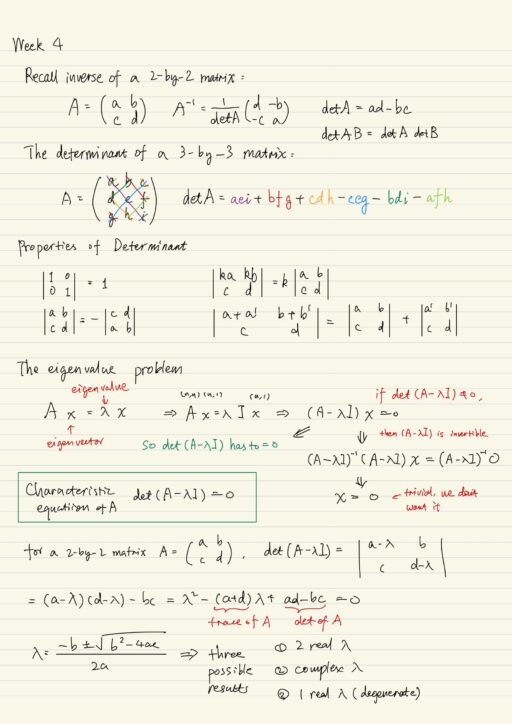Determinants can tell us whether a matrix has an inverse, and more importantly it can help us solve the eigenvalue problems. The eigenvalue problem is another way to look at a square matrix in terms of scalars called eigenvalues, and vectors called eigenvectors.
Determinants
If there is inverse to the matrix of A, you can solve the equation A x = b, by x = A-1 b and b will be a unique solution. The determinants of 2-by-2 and 3-by-3 matrices are easy to calculate. When we need to generalize this to an n-by-n matrix, one of the method is to use Laplace expansion, which helps reduce the level of the determinant by one dimension of the matrix.
Laplace Expansion
Instead of working on only first row, Laplace expansion actually works going across any row or down any column. You have complete freedom to select row to go across or column to go down. The signs of the terms follow the checkerboard patterns, like below:
+ - + - ...
- + - + ...
+ - + - ...
...When calculating the determinant of a matrix, the easiest way is to look for the row or column with most zeros.
Leibniz Formula (Big Formula)
There are n factorial terms when computing the determinant from the Leibniz Formula. The complication is how to determine the sign of terms: try to get the column of choice from order 1, 2, 3 through n, if the number of permutation (flip) is even, you get a plus sign; otherwise it is minus sign.
Properties of a Determinant
Determinant is actually a function that takes an n-by-n matrix and returns a scalar. These 3 properties are all you need to define the determinant function. With these definitions you can prove the Laplace Expansion and Leibniz Formula.
| Property 1 | det I = 1 |
| Property 2 | determinant changes sign under row interchange |
| Property 3 | determinant is a linear function of the first row |
You can use these 3 properties to prove all of these other properties.
- The determinant is linear function of all rows.
- det = 0 if there are 2 rows are identical.
- det = 0 if there is a row of zeros.
- det = 0 implies its matrix is not invertible
- The determinant of diagonal matrix, the determinant of lower triangular matrix, the determinant of upper triangular matrix are just products of diagonal elements.
- det(AB) = det A * det B
- det(A-1) = 1 / det(A)
- det(AT) = det(A). Whatever you do on the rows of a matrix, also applies to the columns of a matrix.
- The determinant of a matrix does not change when you multiply a row with a number and add it to another row. (Gaussian elimination does not affect the matrix’s determinant).
Eigenvalue Problem
Eigenvalue problem was introduced by studying the rotation of solid objects in physics. In quantum physics the eigenvalue were the energy levels of the atoms. Suppose we have a matrix A, you want to find its eigenvalues and its eigenvectors, with the following equation holds:
A x = λ x
x is the eigenvector, λ is eigenvalueFor each eigenvalue, you have an associated eigenvector. In order to get a non-trivial result of vector x. The equation below must hold, and it is called Characteristic Equation of matrix A, which is a n-th order polynomial equation in λ.
det(A - λ I) = 0 -> C1λn + C2λn-1 + ... = 0.The polynomial equation has roots, the roots can be real or complex. All symmetric matrices have real eigenvalues.
Matrix Diagonalization
If a n-by-n matrix A has n linearly independent eigenvectors, then we can do a very nice matrix multiplication on A to transform it into a diagonal matrix, which is very easy to compute with.
Suppose a n-by-n matrix A has n linear independent eigenvectors: x1, x2, …, xn, all of which are used as columns to construct an invertible matrix S (with i-th column is the i-th eigenvector).
Also, A has n eigenvalues: λ1, λ2, …, λn. all of which are used as diagonal elements to construct a matrix Λ (a diagonal matrix with all eigenvalues along the diagonal). So we have this equation:
A S = S Λ
A = S Λ S-1 <- factorization of A
Λ = S-1 A S <- we have diagonalized A into ΛPowers of Matrix
When you want to calculate the powers of a matrix, you may first diagonalize the matrix first to shortcut the calculation.
A = S Λ S-1
A2 = S Λ S-1 S Λ S-1 = S Λ I Λ S-1 = S Λ2 S-1
...
Ap = S Λ S-1 ... S Λ S-1 = S Λ I ... I Λ S-1 = S Λp S-1A diagonal matrix is very easy to raise to a power. The result of raising a matrix to a power is that you just raise the diagonal elements to the power.
My Certificate
For more on Eigenvalues and Eigenvectors, please refer to the wonderful course here https://www.coursera.org/learn/matrix-algebra-engineers
Related Quick Recap
I am Kesler Zhu, thank you for visiting my website. Check out more course reviews at https://KZHU.ai
Don't forget to sign up newsletter, don't miss any chance to learn.
Or share what you've learned with friends!
Tweet


